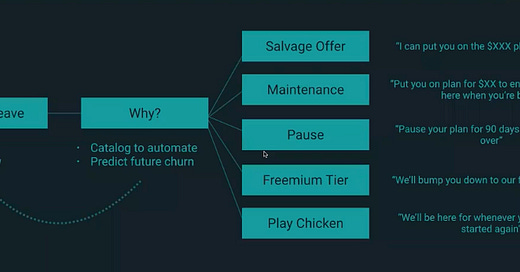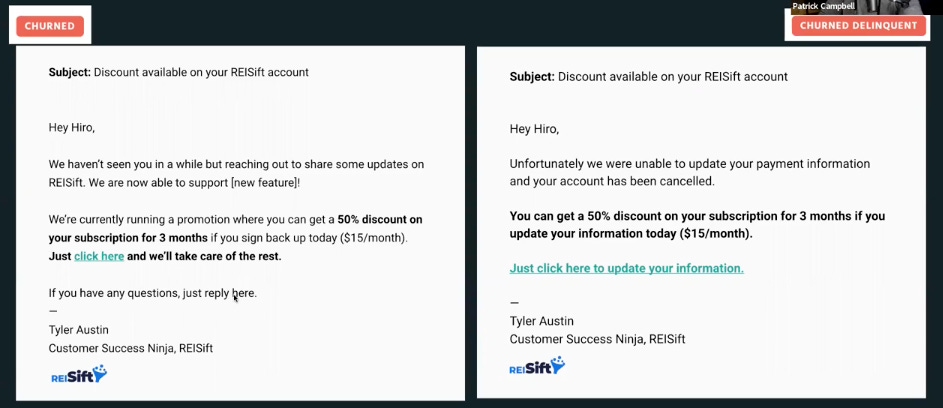💎 Growth Gems #71 - UA (SKAN 4.0) and Retention
Hi!
This week I’m sharing gems on subscriber retention and SKAdNetwork 4.0. These insights come from Patrick Campbell, Piyush Mishra and Roy Yanai.
Enjoy!
🥇 TOP GEM OF THE WEEK
Retention: tactical retention zone, expansion revenue and win-backs
We often hear about a better product being the only way to improve retention.
But post product-market fit, and even more so for scaled products, there are several opportunities you can explore to improve subscriber retention.
While they are not app-focused, Patrick Campbell (CEO at ProfitWell) shared some gems on both fundamentals and tactics that can lead to higher revenue in this Retention Webinar.
This is most relevant if you have a web funnel!
💎 There are 3 big areas in a subscription business: Acquire, Monetize and Retain. Most of the time, you’re spending all your budget/time on the start of that relationship (acquiring users).
by Patrick Campbell (CEO at ProfitWell)
at 05:34
💎 We have a misconception when it comes to retention: we think it’s only solved through providing value to the customer. This is incomplete: if you think about the value only, you’re spending all your efforts on the end parts of the value spectrum (Strategic Retention) and forgetting what’s in between (Tactical Retention Zone).
by Patrick Campbell (CEO at ProfitWell)
at 08:49
💎 Look at the 3 big parts of your retention:
Active cancellations - customers actively cancelling your product because they don’t want it anymore
Expansion revenue - existing customers spending more with you by buying more of your existing products
Payment failures
by Patrick Campbell (CEO at ProfitWell)
at 11:00
💎 The #1 thing to deal with active cancellations is to make sure you have a great product team. But from a tactical standpoint, you want to do plan optimization: if you get more customers on your long-term plans, your LTV will go up and your cancellation rate will go down.
by Patrick Campbell (CEO at ProfitWell)
at 11:55
💎 Most businesses only ask customers to upgrade to a longer-term plan when they first sign up. The issue is that these customers haven’t seen the value of the product yet. You need to ask for the upgrade beyond sign up.
by Patrick Campbell (CEO at ProfitWell)
at 13:22
⛏️ Going Deeper: Patrick also shared that when offering an upgrade, 2 months free works much better than the equivalent percentage. He argues this is because it takes customers more thought cycles to understand the % off while X months free is more concrete.
💎 Ideally, make it so users don’t have to actually login to upgrade (i.e. they can just reply to the email or double-click in).
by Patrick Campbell (CEO at ProfitWell)
at 14:21
💎 When people want to cancel, do a 2-questions survey:
Why are you leaving? Use a multiple choice question.
What did we do well? This helps you for the product but it also reminds users of what they liked about the product.
by Patrick Campbell (CEO at ProfitWell)
at 15:50
⛏️ Going Deeper: Patrick mentioned answers like:
I didn’t have time to see the value
I couldn’t get a hold of someone in sales/support
You’re missing critical features
Everything is great, I’ll be back
Some of these might be a bit more SaaS-related. So below are examples from Flo, 8Fit and Uptime for inspiration.
💎 After the survey, offer them something to stick around based on their answer (e.g. extra month, $X off, an add-on). These offers work because there are a lot of reasons people are cancelling that have nothing to do with you or that are fixable.
by Patrick Campbell (CEO at ProfitWell)
at 17:25
💎 The biggest mistake people make with pausing plan is they make it indefinite. You need to time-box it (e.g. 1 month, 3 months).
by Patrick Campbell (CEO at ProfitWell)
at 19:40
💎 Another big mistake that people make is they offer salvage offers to everyone. It’s totally ok to let customers leave and try to reactivate them down the line.
by Patrick Campbell (CEO at ProfitWell)
at 19:50
💎 Don’t forget to try and win-back customers. You’ve done the hardest part by making customers aware of your product. A lot of the time their cancellations have nothing to do with you and you should try to get them back by reminding them of new features and giving them an offer.
by Patrick Campbell (CEO at ProfitWell)
at 20:45
💎 When trying to win back customers, offering big percentages off can work (vs. upgrades where it’s best to have X months free). If it’s less than 50%, use $X off. You should be able to get 20% or more cancelled customers back through reactivations.
by Patrick Campbell (CEO at ProfitWell)
at 21:52
💎 If you’re not post product-market fit, win-backs are not going to help you.
by Patrick Campbell (CEO at ProfitWell)
at 22:40
💎 Payment failures are the largest single bucket of lost customers (20-40% of lost customers). There are 130+ different reasons a credit or debit card fails. You should recover 60-80% of customers who’s payment fails.
by Patrick Campbell (CEO at ProfitWell)
at 33:24
💎 Do not use email before a point of payment failure. Email correlates with +11%-18% higher active cancellations. Use in-app notifications instead.
by Patrick Campbell (CEO at ProfitWell)
at 35:37
💎 If you’re a consumer product, the best time to retry credit card payment is payday: 12:01am PT on the last day of the month and the 15th of the month.
by Patrick Campbell (CEO at ProfitWell)
at 38:05
💎 After the point of failure, do not use stylized emails. Use plain text, it gets better open rates and people actually updating their card info (+50% engagement).
by Patrick Campbell (CEO at ProfitWell)
at 38:55
💎 Make sure your users don’t have to log in to update their credit cards.
by Patrick Campbell (CEO at ProfitWell)
at 40:35
💎 You can add cancellation flows for downgrades as well. Use a multiple choices question to understand why they’re downgrading.
by Patrick Campbell (CEO at ProfitWell)
at 1:10:18
Acquisition: SKAdNetwork 4.0
There were insights from 5 MMPs on measurement in Growth Gems #68, and so I mentioned SKAN 4.0 (which came out right after the session).
Apple seems to have made a lot of improvements, yet this might not be the absolute game changer you think.
Roy Yanai (Director of Product at AppsFlyer) discussed this with Adam Smart and Piyush Mishra in episode 7 of “In the sandbox with…” The one with the SKAD changes.
Some gems below on the nuances and subtleties of what’s to come.
💎 Google Search paid performance should be trackable with SKAN 4.0.
Roy Yanai (Director of Product at AppsFlyer)
at 05:40
⛏️ Going Deeper: right now, there is no Web2App tracking on iOS. In fact, since Apple introduced Intelligent Tracking Prevention (ITP) advertisers have had to rely on Google Ads’ numbers (now modeled conversions) to get a sense of their Google UAC performance on iOS (otherwise the Google Search placements are not accounted for).
With SKAN 4.0 (cf. WWDC session here), Apple will give a way to track Web2App. It seems that you will need to add a redirect to the App Store in the HTML (which will include the nonce identifier and the ad network that’s behind the ad). Then:
The App Store then reaches out to a configured end point of that ad network to ask for a unique impression id (the ad signature), which the ad network returns.
This unique impression id is matched with the impression/click registered by Apple at the OS level.
I have reservations on Google actually wanting to add the code needed so advertisers can assess performance outside of their platform. For example, they haven’t done it for Custom Product Pages yet (few networks have). Roy argues that they will do it because this time it will add attributions to them (CPPs don’t). So wait and see!
💎 Source id can now have 4 digits (decimal, not binary). Ad networks can encode any campaign breakdown they wish to encode within these 4 digits, and later decode it: campaign ids, geo, placement, ad, etc.
Roy Yanai (Director of Product at AppsFlyer)
at 07:40
💎 There is now a dedicated privacy threshold for the source id. You will always get at least 2 digits, but there is a privacy threshold where you get 3 digits and then another one where you get 4 digits. This means ad networks can’t do anything they want with the 10,000 options: there is a risk for advertisers to not get the 3rd digit, and an even higher risk to not get the 4th digit.
Roy Yanai (Director of Product at AppsFlyer)
at 08:40
💎 The first breakdown networks will probably provide advertisers with the extra digits is probably geo. But advertisers will only benefit if they meet the privacy threshold(s).
Roy Yanai (Director of Product at AppsFlyer)
at 12:40
💎 When it comes to conversion values, there are 3 possible postbacks that are going to be sent for each user. If the user is active within a window, the postback is sent at the end of the corresponding time frame:
0-2 days
2-7 days
7-35 days
Roy Yanai (Director of Product at AppsFlyer)
at 14:28
💎 There used to be two timers: one to reset the conversion value (this first timer does not exist anymore), and the random timer. At fixed times, the second timer will start working so we will have postbacks:
After 2 days (+ random timer)
After 7 days (+ random timer)
After 35 days (+ random timer)
Roy Yanai (Director of Product at AppsFlyer)
at 15:00
⛏️ Going Deeper: at the moment, you receive a postback between 24h to 48h so this change in SKAN 4.0 is actually going to make it worse from a “data freshness” perspective.
💎 For the first SKAN 4.0 postback, there are 2 different conversion values but also 3 levels of privacy thresholds:
Fine grain - 0 to 63 (the one we know). You receive it if the highest level of privacy threshold is met.
Corse grain - low/medium/high. You receive it if the highest level of privacy threshold is not met.
If none of the privacy thresholds are met, you get a null value.
Roy Yanai (Director of Product at AppsFlyer)
at 18:17
💎 For the 2nd and 3rd postbacks, there is no fine grain: you either get corse grain or null.
Roy Yanai (Director of Product at AppsFlyer)
at 18:58
💎 What’s not explained yet by Apple’s documentation is whether you can tie the 3 postbacks to the same user.
Roy Yanai (Director of Product at AppsFlyer)
at 19:34
💎 You need to define the schema for low/medium/high for the 2nd and 3rd conversion windows/postbacks (corse grain only, no fine grain). Example by “user value”:
Low: completes X levels
Medium: paying user
High: high paying user
At the end, you get one of these values if the lower privacy threshold is met.
Roy Yanai (Director of Product at AppsFlyer)
at 18:58
💎 Web2App will be supported for all browsers, not only Safari. And it will work for owned media also, not only paid.
Roy Yanai (Director of Product at AppsFlyer)
at 23:20
💎 Apple writes the documentation, but the MMPs are doing the execution. And it’s not always how it was written.
Piyush Mishra (Head of Growth Marketing at Product Madness)
at 26:53
💎 There are no dates mentioned yet for SKAN 4.0 (iOS 16? End of the year?). Plus, once SKAN 4.0 releases it’s going to take another 3 to 4 months to be adopted by advertisers and publishers.
Piyush Mishra (Head of Growth Marketing at Product Madness)
at 28:15
And before I leave, Piyush’s reaction after hearing we’ll need to define new conversion value schemas:
“You’re in for a treat!” - Piyush Mishra (Head of Growth Marketing at Product Madness)
See you next time. Stay savvy!
⛏️ Sylvain
















